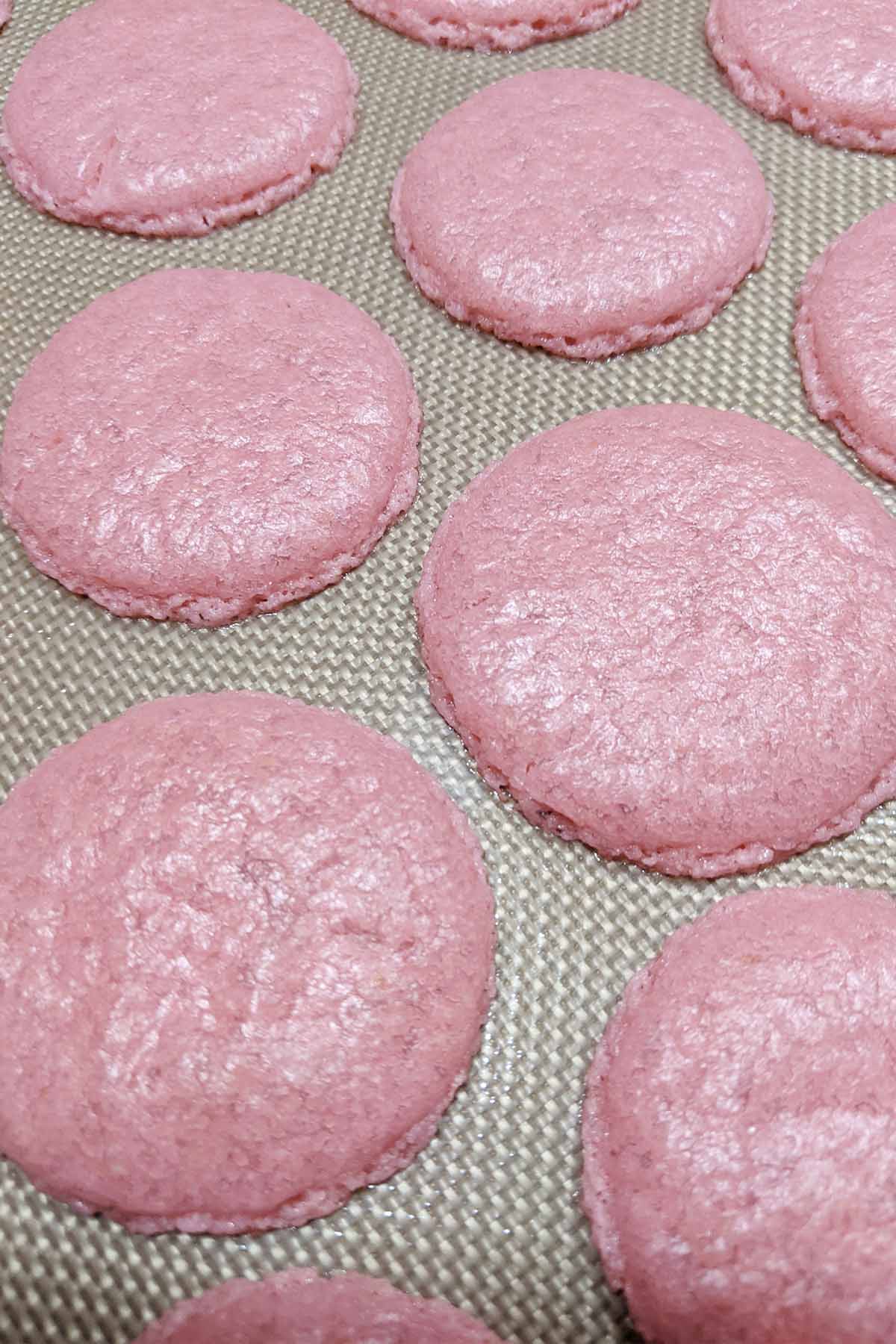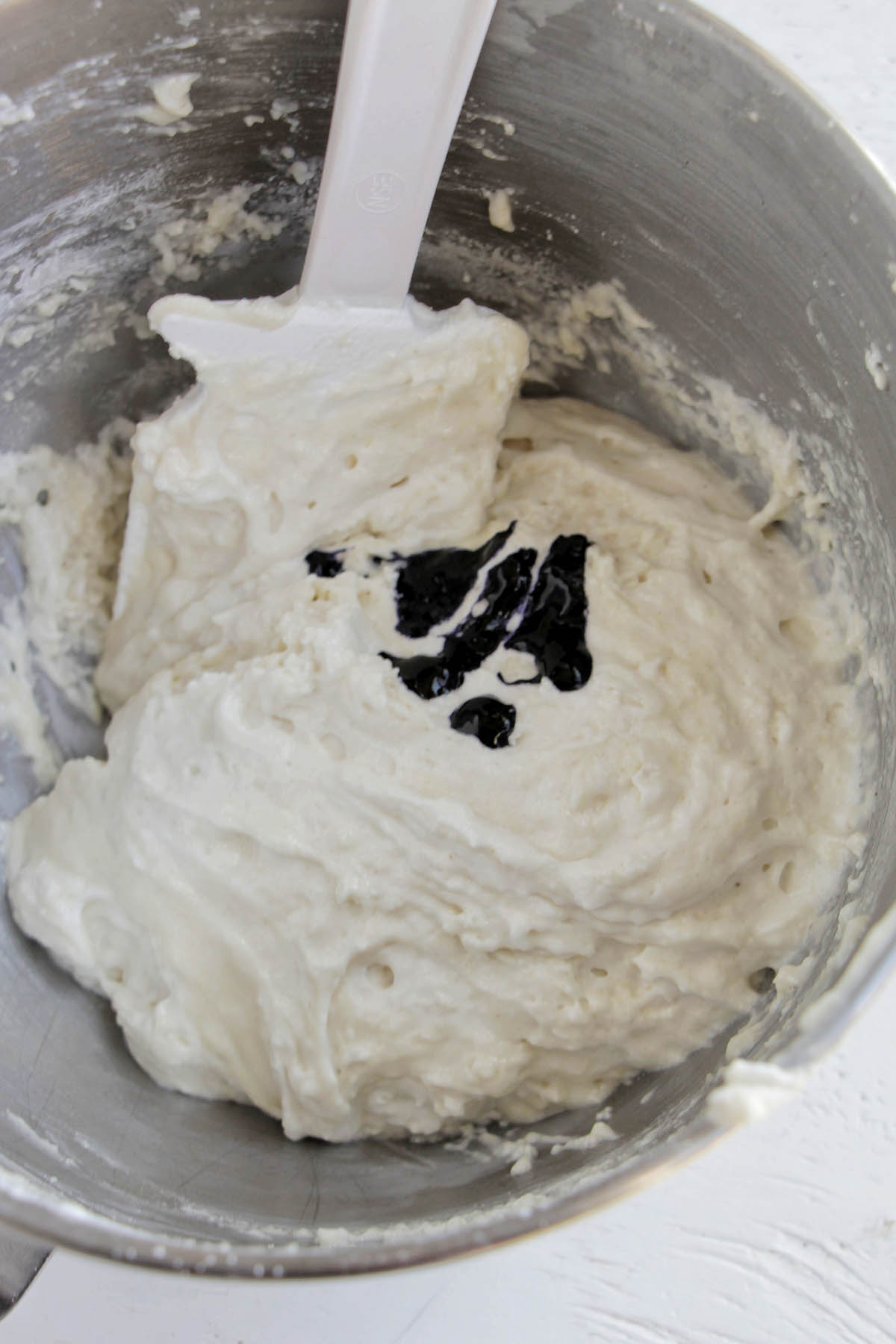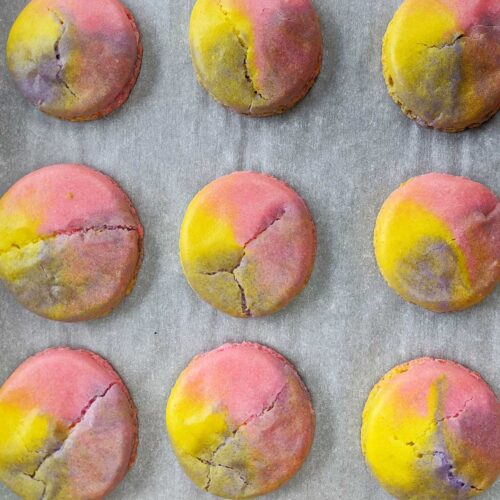Have you been wondering why your macarons are flat or not rising? Use this troubleshooting guide to fix any equipment, technique, or ingredient issues that may be causing flat macarons.

Want To Save This Article?
Enter your email below and we'll send it straight to your inbox. Plus, you'll receive new weekly recipe inspiration.
Baking macarons at home has become one of my favorite hobbies!
But, if you've ever attempted to make macarons at home, you know how frustrating the process can be. Macarons are known for being finicky and oftentimes troublesome.
Even the best pastry chefs still have off days when their macarons turn out poorly.
I'm here to help you fix any issues you may be having with flat macarons. Whether your macarons are baking up too flat, or they're simply not rising in the oven, we will talk about potential issues you could be running into, and how to remedy these problems.
As always, remember that it takes some trial and error to bake macarons at home. Don't give up on your first or second attempt, keep going!
You can always refer to my macaron troubleshooting video, or leave a comment below, and I'll do my best to help you out.
Jump to:

What You'll Learn In This Article
- The importance of oven temperature and how it could be causing flat macarons.
- The crucial techniques you must master in order to avoid macarons that are flat.
- Ingredients that could be preventing your macarons from properly rising.
If you are looking for some more specialized help with troubleshooting your macaron problems, sign up for my free macaron troubleshooting guide sent straight to your email.
Equipment Related Issues
The equipment that you're using could be causing your macarons to fall flat. Here is a common equipment-related issue you should check:
1. Oven temperature is too low or too hot: Oven temperature plays a huge role in how your macarons turn out. In fact, this is probably the number one issue for experienced bakers who are having trouble with their macarons.
Oven temperatures that are too low or too high can cause all sorts of issues including flat macaron shells, wrinkly shells, cracked shells, or improper macaron feet.
If your oven is too low, you'll notice that the macarons won't properly rise. Not only will they be flatter than a normal macaron, but the feet will be short (under 2 millimeters), and the tops will likely be wrinkly or indented.
On the other hand, if your oven is too hot, the shells will be flat because proper feet will not form. The macarons will bake too quickly on the outside, leaving a moist interior that doesn't properly rise.
Generally, if your oven is too hot and causing flat macarons, you'll notice some browning or cracking of the shells.
If you're interested in learning more about how oven temperature affects macarons, check out the at-home experiment I conducted.

Technique Related Issues
Making perfect macaron shells has a lot to do with learning the proper techniques and mastering them. Here are some techniques you may have messed up that could result in flat macarons:
1. Under whipped meringue: Properly whipping your meringue (a mixture of sugar and egg whites) is a very important technique in macaron baking.
The meringue should be whipped to stiff peaks (not over or under). No matter what type of meringue you make, French-style, Italian, or Swiss meringue, it should always be whipped to stiff peaks.
Under whipped meringue won't be strong enough to properly rise in the oven. It can lead to flat, wrinkled, or weak macaron tops.
In order to achieve stiff peaks, you need to learn the visual cues you can use to know that your meringue has whipped to stiff peaks:
- You'll notice the meringue starts to ball up inside the whisk while it's mixing.
- Pull the whisk out of the mixer. A stiff peak should stand straight up (no curl at the tip).
- You can see pointy off-shoots of egg whites on the whisk when you pull it out of the mixer.
- You can fully flip the bowl over and nothing moves or falls out.
- The meringue feels sturdy (not flimsy).
- The egg whites hold the indentation that the whisk makes as it's whipping.
It typically takes around 8 - 10 minutes to reach stiff peaks, depending on your mixer and the speed. I use a KitchenAid mixer on speed 7.
Additionally, if you're making French (common) meringue, make sure to slowly add the granulated sugar during the whipping process. This allows the sugar crystals time to dissolve so they don't weigh down the egg whites.
If the sugar is added too quickly, it can affect the final structure, resulting in an under-whipped and weak meringue.

2. Over macaronaged: Another common issue that results in flat macarons is over macaronaged batter.
Macaronage is a term that refers to folding the dry macaron ingredients (almond flour and confectioners' sugar) into the meringue. This process smooths the mixture and helps the macarons bake with proper structure.
When you over macaronage, you'll notice the batter is very thin and easily falls off the spatula. You'll also notice that the batter spreads really easily when piped. It might even fall out of your piping bag when transferring from one circle to the next on your piping template.
To properly macaronage, continue folding the batter just until it reaches a lava-like consistency. You can test this by lifting your spatula and seeing if the batter drops almost like lava. Once it drops off the spatula, the batter that was dripped should fade back into the batter within 15 - 30 seconds.
If you're new to making macarons, most home bakers tend to over macaronage. If you have doubts as to whether your batter is properly macaronaged, it's generally better to under macaronage since the batter will continue to be worked in the piping bag.

3. Not resting long enough: Before baking your macarons, it's important to allow the shells enough time to rest. Without proper resting time, the macarons won't rise to their full potential in the oven, typically resulting in a flat macaron.
There are many recipes that only suggest a 20 - 45 minute rest time. That is not enough time in many cases.
Usually, you'll need to allow the shells to rest for about 45 - 60+ minutes on the counter until a skin has formed on top. If you live in a humid climate, this may take up to 90+ minutes.
To test that the macarons are ready to bake, you can feel the shells and visually inspect the macarons. Here's what to look for:
- The shells appear matte in color (not shiny like when you first piped them).
- They are dry to the touch. You should be able to run your finger along the top of the shell without making an indent.
- When you gently and lightly push down on the macaron shell, you can feel some resistance and no mark is left.
You'll notice in the image below that a longer rest period resulted in fuller and thicker macaron shells. If you're having trouble with this, check out my tips for how to fix macarons that aren't drying.

4. It's too humid: If you live in a climate that's very humid or rainy, this could lead to problems with your macarons drying.
Try running the air conditioning or a dehumidifier in your kitchen to take some of the moisture out of the air. Don't run any water in your sink to avoid adding excess moisture to the air.
Additionally, consider allowing the macarons to dry on your counter for 90+ minutes. It's a lot easier to under-rest your macarons compared to over-resting them, especially if it's a humid day.
You can also bake a test batch of macarons once you think they've properly rested in order to see how they respond in the oven.
Ingredient Related Issues
Macaron ingredients play an important role in how your macarons look after they're baked. Whether you're developing your own recipe or following a well-tested recipe, it's important to pay attention to the ingredients you're using.
1. Too much liquid: Sometimes a macaron batter that's too wet can cause your macarons to bake up flat or wrinkled.
To resolve this issue, try aging the egg whites. To age egg whites you'll separate the egg whites from the yolks 2 - 5 days before baking the macarons. Place the egg whites in a container covered with plastic wrap.
Poke a couple of holes in the plastic wrap, and place the eggs back in the refrigerator. This allows some of the water to evaporate in the fridge.
Once you're ready to bake, allow the egg whites to come to room temperature before whipping them into meringue.
If you're developing your own recipe, you can also try reducing the amount of egg whites in your formula.

2. Too much food coloring: Adding an overabundance of food coloring might be causing your flat macarons.
Even if you're using the suggested gel coloring or powdered food coloring, too much can cause the macarons to flatten in the oven.
If you're trying to achieve really dark, opaque-colored shells, this might be your issue for flat macarons. Try reducing the amount of food coloring you add to the macaron batter.

3. Not enough granulated sugar: If you're developing your own macaron recipe, your ratio might be incorrect. If you consistently see flat macarons with no feet and a wrinkly-looking top, you might need to add more granulated sugar to your recipe.
Chef Kathryn Gordon who wrote Les Petits Macarons suggests to slowly increase the granulated sugar in your formula by 1 - 2 tablespoons.

Expert Tips
- Flat macarons can often be paired with other macaron problems such as cracked tops, wrinkled shells, or macaron feet that didn't properly form. Be sure to check out my other troubleshooting guides to see how these issues may overlap.
- It's really important to learn how to properly whip your meringue. This is a big issue that results in flat macarons not rising in the oven. If you're struggling with getting the meringue to stiff peaks, try making Swiss-style or Italian meringue style macarons. These varieties are known for their stiffer meringue.
- Another key technique to master is the macaronage process. Thin macaron batter will almost always result in macarons that are flatter than they should be.
FAQs
There are a few reasons your macarons might not be rising in the oven including equipment, technique, and ingredient related issues:
- Your oven temperature may be too cold or too hot.
- You under whipped your meringue.
- You over macaronaged the macaron batter.
- The macarons didn't rest long enough to properly dry.
- There's too much liquid in the macaron batter.
- You used too much food coloring.
- The recipe doesn't use enough granulated sugar.
In order to get your macarons to rise more in the oven, there are a few techniques you should fine-tune:
1. Make sure you are properly whipping the meringue to stiff peaks.
2. Properly macaronage the macaron batter until it is the perfect lava-like consistency.
3. Adjust your oven temperature. This takes some trial and error to find the perfect temperature for your home oven. You can see how I experimented with my oven temperature and how that affected the baked macarons.
Here are some common reasons your macarons are turning out flat after they're baked:
- Your oven temperature may be too cold or too hot.
- You under whipped your meringue.
- You over macaronaged the macaron batter.
- The macarons didn't rest long enough to properly dry.
- There's too much liquid in the macaron batter.
- You used too much food coloring.
- The recipe doesn't use enough granulated sugar.
More Macaron Troubleshooting Guides
Love this guide? Please leave a comment below. Don't forget to follow along on Instagram, Facebook, YouTube, and Pinterest for more recipes.










Leave a Reply